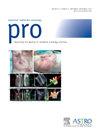在美国,贝伐单抗是否是治疗脑放射性坏死的具有成本效益的方案?放射性坏死药物的成本效益分析。
IF 3.4
3区 医学
Q2 ONCOLOGY
引用次数: 0
摘要
背景:贝伐单抗已被证明在治疗脑放射性坏死(CRN)方面具有卓越疗效,但其高昂的费用可能会加重疾病负担。本研究旨在从美国支付方的角度评估贝伐单抗与皮质类固醇相比治疗 CRN 的成本效益:方法:构建决策树模型,模拟贝伐单抗和皮质类固醇在 CRN 短期和长期治疗中的过程。关键临床数据来自 NCT01621880 试验。成本和效用值来自美国官方网站和已发表的文献。主要结果为总成本、质量调整生命年(QALYs)和增量成本效益比(ICER)。为评估模型的稳健性,进行了单向和概率敏感性分析:在短期和长期模型中,贝伐单抗比皮质类固醇疗法分别增加了 0.11 (0.46 vs 0.35) 和 0.16 (0.54 vs 0.38) QALYs,相应的增量成本分别为 12,351 美元和 23,253 美元。因此,短期和长期治疗的 ICER 分别为 112,987 美元/QALY 和 150,245 美元/QALY。单向敏感性分析表明,不复发状态的效用值、体重和贝伐珠单抗每个周期的价格是对两个模型的 ICER 影响最大的因素。在美国,当支付意愿阈值为 150,000 美元/QALY 时,贝伐珠单抗用于 CRN 短期和长期治疗的成本效益概率分别为 63.9% 和 49%:结论:从美国付费者的角度来看,与皮质类固醇相比,贝伐单抗是 CRN 短期治疗的经济替代方案,而长期治疗的结论则与之相反。本文章由计算机程序翻译,如有差异,请以英文原文为准。
Is Bevacizumab a Cost-Effective Regimen for Treating Cerebral Radiation Necrosis in the United States?
Background
Bevacizumab has been demonstrated to have superior efficacy in the treatment of cerebral radiation necrosis (CRN), but its high cost may exacerbate the disease burden. This study aimed to assess the cost-effectiveness of bevacizumab in comparison to corticosteroids for treating CRN from the US payers’ perspective.
Methods
Decision tree models were constructed to simulate the process of bevacizumab and corticosteroids in CRN short-term and long-term therapy. Critical clinical data were derived from the NCT01621880 trial. Costs and utility values were obtained from the US official websites and published literature. The main outcomes were total costs, quality-adjusted life-years (QALYs), and incremental cost-effectiveness ratio (ICER). One-way and probabilistic sensitivity analyses were performed to assess the robustness of the models.
Results
In the short-term and long-term models, bevacizumab added 0.11 (0.46 vs 0.35) and 0.16 (0.54 vs 0.38) QALYs compared with corticosteroids therapy, with corresponding incremental costs of $12,351 and $23,253, respectively. The resultant ICERs were $112,987/QALY and $150,245/QALY for short-term and long-term treatment, respectively. The one-way sensitivity analysis indicated that utility value of nonrecurrence status, body weight, and bevacizumab price per cycle were the most influential factors for ICER of both models. At the willingness-to-pay threshold of $150,000/QALY in the United States, the probabilities of bevacizumab being cost-effective for CRN short and long-term treatment were 63.9% and 49%, respectively.
Conclusions
Compared with corticosteroids, bevacizumab is an economical alternative for CRN short-term treatment from the US payers’ perspective, whereas long-term therapy draws an opposite conclusion.
求助全文
通过发布文献求助,成功后即可免费获取论文全文。
去求助
来源期刊

Practical Radiation Oncology
Medicine-Radiology, Nuclear Medicine and Imaging
CiteScore
5.20
自引率
6.10%
发文量
177
审稿时长
34 days
期刊介绍:
The overarching mission of Practical Radiation Oncology is to improve the quality of radiation oncology practice. PRO''s purpose is to document the state of current practice, providing background for those in training and continuing education for practitioners, through discussion and illustration of new techniques, evaluation of current practices, and publication of case reports. PRO strives to provide its readers content that emphasizes knowledge "with a purpose." The content of PRO includes:
Original articles focusing on patient safety, quality measurement, or quality improvement initiatives
Original articles focusing on imaging, contouring, target delineation, simulation, treatment planning, immobilization, organ motion, and other practical issues
ASTRO guidelines, position papers, and consensus statements
Essays that highlight enriching personal experiences in caring for cancer patients and their families.
 求助内容:
求助内容: 应助结果提醒方式:
应助结果提醒方式:


